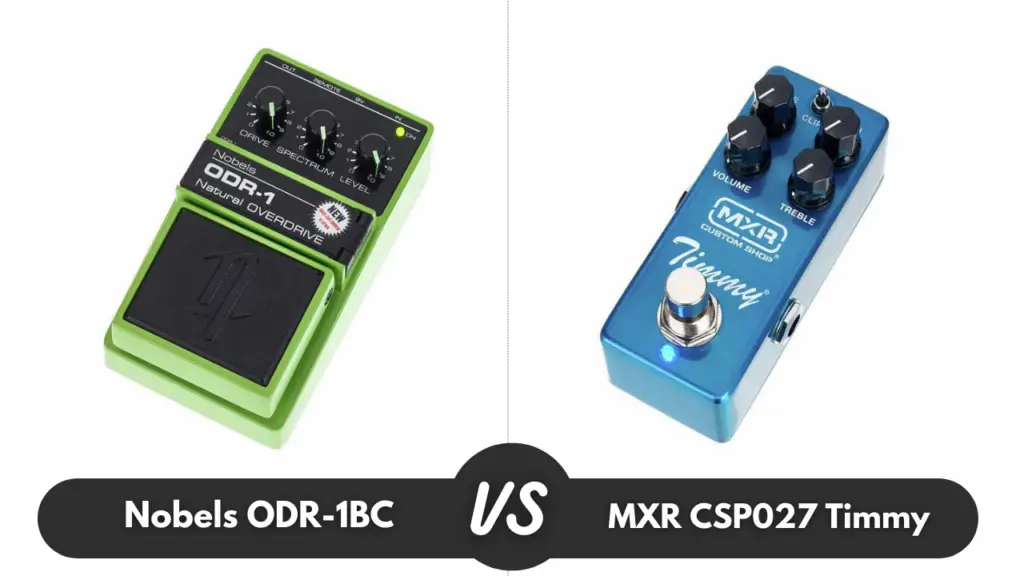Overdrive pedals are a huge factor for most guitar players, which is one reason there are so many of them on the market. Unlike the majority of other effects units, overdrive pedals aren’t there to drastically change your tone and rather to enhance what’s already there. A quality overdrive pedal adds colour to your sound, as opposed to changing the picture completely. As they rarely have as much gain as distortion or fuzz pedals, they’re a little more subtle, adding a bit more grit, sustain and, if dialled in, the overall volume.
| Features: | Nobels ODR-1BC | MXR CSP027 Timmy |
|---|---|---|
| Price: | £97 ($115) | £125 ($147) |
| Controls: | Drive, Spectrum/Tone and Level | Bass, Treble, Volume, and Gain |
| Versatility: | Good | Better |
Nobels ODR-1BC
The ODR-1 is a great pedal for blues and crunchy rock sounds (or for that extra punch when soloing). The pedal has been the first choice and secret weapon for many players and top studio guitarists for nearly 30 years. As the ODR-1 has been a top-selling pedal, it has developed its own almost cult following since it was first designed and engineered in the eighties.
When the original circuit was developed, there seemed to be countless overdrive pedals on the market that have had many people describe as producing too much of a ‘nasal’ tone, however, Nobels worked hard on creating a very ‘open’ sounding pedal that works with you and your amplifier. This resulted in the ODR-1, with German engineering at its finest, including stacks of resistors and capacitors forming very precise filters and signal shaping, giving you a pedal that responds to your dynamics and adds texture to your tone in a very natural, musical way – all while allowing the character of your guitar to be fully retained.
Tone
While it adds a very effective tonal tweak, tightening up the real low-end for those who want it, you can achieve a standard sound with its full-bodied warmth.
The ODR-1 is capable of giving a fully driven sound but it also provides some magic that comes from the lower reaches of the drive knob where you find early break-up and low-level crunch that can add just the right amount of grit to a clean amp for core tone or as a solo booster.
Performance
Overall, the ODR-1 falls somewhere between a typical Tubescreamer clone (and its signature scooped mids) with a clean booster, featuring a natural and smooth overdrive that works great on everything from blues to classic rock, indie and more. Nobels ODR-1 provides a lot of versatility inside this little green pedal.
The natural boost can be used for lower levels, pushing the signal with just a hint of color (which works exceptionally well when paired with a tube amp). When pushing the Drive further it goes into OD territory, delivering a smooth tube-like overdrive featuring a nice amount of sustain and rich harmonics that sounds great on country and blues licks. When pushed even further, you’re into full-on distortion, thick and aggressive, but maybe a bit too boomy for most players.
MXR CSP027 Timmy
Guitarists that span all genres, will commonly agree that there’s no finer feeling than finding that holy grail of guitar tone, however, where exactly do you turn to when you need to add a little more overdrive, without tainting your hard-earned tone? This is where veteran pedal builder Paul Cochrane steps in.
Paul was one step ahead when it came to this predicament and so decided to build an overdrive pedal that would add girth to your tone, while at the same time preserving the characteristics of the original signal – and just like that, the original ‘Timmy’ overdrive was created.
Sound
The MXR is a touch-sensitive overdrive that works with your playing, a neutral dealer of crunch and output between the amplifier and guitar, which is really all that’s meant by transparent.
Whether you set the MXR as a clean boost to hit your amp’s front end harder or dial in some heavier crunch, the pedal’s dynamics are exceptional. Rolling back your guitar’s volume control opens up a wide range of drive that can work for rock through to blues without touching the pedal’s settings.
There’s something inherently musical about the Timmy’s brand of overdrive pedals. As it enhances the harmonic response of your amplifier, feeding it some extra juice so that you can really lean into and dig in with.
Sure, having the bass and treble controls as cut only won’t make for everyone’s idea of a good time. However, it’s not difficult to find the sweet spot that makes your amp and guitar sing.
Nor will it be hard to find a spot on your pedal board for the MXR. As it’s a more affordable, more compact option, you would find it difficult to mount a case for shelling out big bucks on an original unit.
There’re so many overdrive pedals on the market right now. Some inevitably will get lost in the mix. But not Timmy’s MXR. This overdrive arrives on the back of a legend living up to its reputation as a pedal board must-have.
Conclusion
It’s a tough decision as both are quality overdrive pedals. Not only do both offer a wide range of gain, but they can also let enough bass through.
If you wanted to go into nuances, they compress differently. The Nobels ODR-1BC
has a different inherent EQ and midrange. The flexibility for dialling in the midrange is quite different in the Nobels.
While there isn’t a lot of difference tonally between the ODR-1BC and MXR CSP027, the MXR CSP027 has better EQ controls, it also has switchable clipping/compression options.
